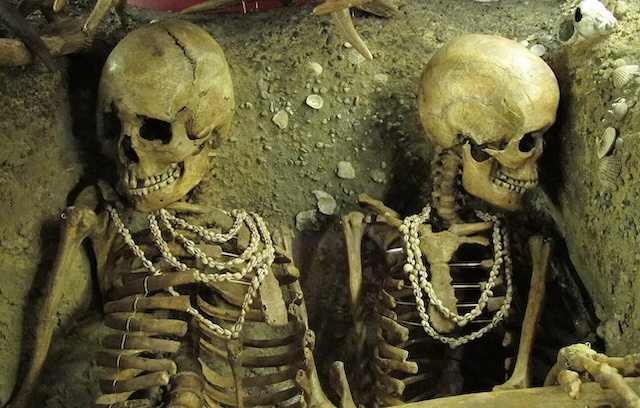The grave of the Ladies of Téviec, discovered off the coast of Brittany, France, unveils a haunting tale from 6,500 years ago. These two women, buried under a roof of antlers and surrounded by artifacts, met violent and mysterious ends. Their remains, adorned with signs of trauma, raise questions about the rituals, beliefs, and conflicts of Mesolithic societies, leaving researchers captivated by the secrets of their ancient lives.
6500-Year-Old Grave of the Unfortunate Ladies of Téviec!
Téviec Island, located off the coast of Brittany in France, has long been a site of archaeological fascination. This small island has yielded many discoveries from the Mesolithic era, the most intriguing of which is the 6,500-year-old grave of two women, now referred to as the “Ladies of Téviec.” The burial site provides a rare glimpse into the lives, culture, and possible violent demise of these individuals. Their burial, marked by a remarkable structure and the presence of valuable artifacts, raises questions about their status and the circumstances of their death. Let’s delve into the story of this ancient grave and what it reveals about the mysteries of prehistoric life.
The Discovery and Nature of the Grave
The grave of the Ladies of Téviec was discovered between 1928 and 1934 by archaeologists Marthe and Saint-Just Péquart. Téviec Island, which is one of the few known Mesolithic sites in Brittany, has been under biotope protection for over 35 years to preserve its archaeological significance. The island also holds other important prehistoric sites, including Pointe de la Torche and Hoëdic.

During the excavation, researchers unearthed a site rich in cultural artifacts dating from the late Mesolithic to early Neolithic period. Among these finds was a particularly notable pit grave. This grave, partially dug into the ground and covered with a layer of midden (a pile of discarded shells, bones, and other refuse), offered valuable insights into the daily life and diet of ancient communities. The midden included remnants of oysters, clams, fish, dogs, lobsters, and boar, illustrating the variety of resources available to the people of that era.
The burial of the Ladies of Téviec stands out due to its intricate construction. A roof made from deer antlers covered the pit, offering protection to the bodies within. The surrounding grave goods included flint tools, boar bones, and an array of jewelry crafted from seashells, such as necklaces, bracelets, and leg rings. The presence of these items suggests that these women may have held a special status in their community. The care taken in their burial reflects the importance of their lives and the mysterious circumstances of their deaths.
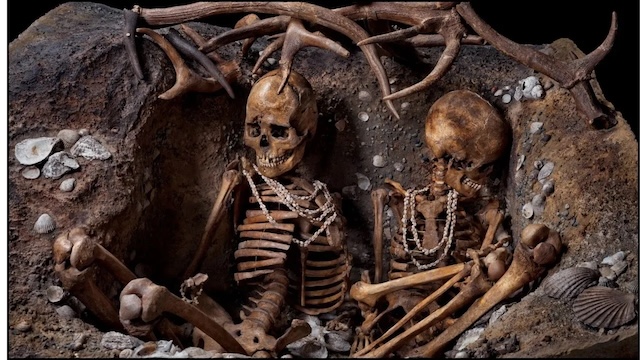
Forensic Analysis and Exhibition
Forensic analysis of the skeletons provided a shocking revelation about the violent end these women may have faced. One of the women had sustained multiple blows to the head, with at least two of these injuries potentially being fatal. Additionally, an arrow was found embedded between her eyes. The other woman also exhibited signs of trauma, though less severe. These findings have led to debates among archaeologists as to whether these injuries resulted from interpersonal violence or were caused post-mortem due to soil pressure above the grave.
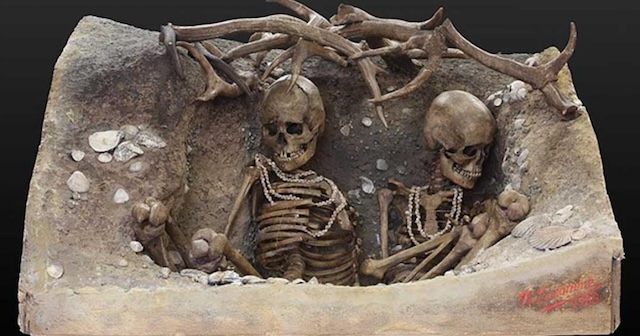
In 2012, the remains of the Ladies of Téviec were showcased in an exhibition titled “Prehistory: The Investigation” at the Toulouse Natural History Museum. This exhibition featured replicas of the skeletons laid on a mortuary slab, aiming to give the public an understanding of the Mesolithic period through forensic investigation. It attracted over 100,000 visitors in Toulouse and 200,000 in Paris. Dr. Francis Duranthon, director of the Toulouse Natural History Museum, emphasized the importance of the exhibition by stating, “When you create an exhibition, you need to create an atmosphere, and a lot of TV shows are about CSI and forensics, and they always start with a forensics table – and here it is.”
The exhibition also offered insights into the lifestyle of the community to which these women belonged. Analysis of their bones indicated a diet rich in seafood and meat, suggesting that the community was engaged in fishing, hunting, and possibly small-scale farming. This information, coupled with the evidence of violent injuries, has provided a more comprehensive picture of the social dynamics and possible conflicts within their society.
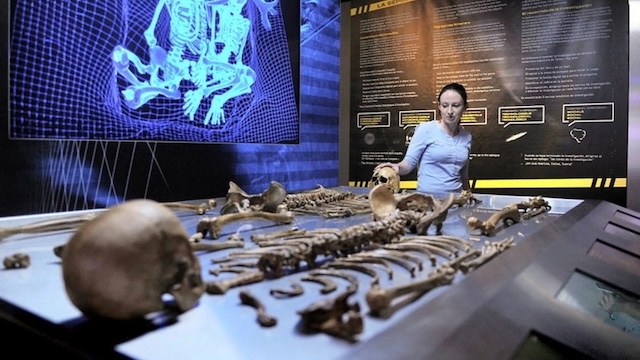
Possible Theories Regarding Their Demise
The violent nature of the deaths of the Ladies of Téviec has sparked several theories. One possibility is that they were victims of a raid conducted by a rival group seeking resources. During the Mesolithic period, such raids were common, and the evidence of trauma supports this theory. The arrow found embedded between one of the women’s eyes indicates the use of weapons in their death.
Another theory suggests that the women may have been victims of ritual sacrifice. The elaborate nature of their burial, including the antler roof and surrounding grave goods, could signify that their deaths had ceremonial importance. This idea is supported by the severe nature of their injuries, which may point to a ritualistic practice aimed at appeasing deities or addressing environmental stressors.
Environmental factors could have also played a role in their demise. Historical records indicate that Mesolithic communities often faced challenges such as droughts, hailstorms, and food shortages. In times of crisis, societies might have turned to rituals or sacrifices to seek favor from their gods or restore balance. The grave of the Ladies of Téviec may represent such a practice, reflecting the complex interplay between environmental conditions and social customs in ancient times.
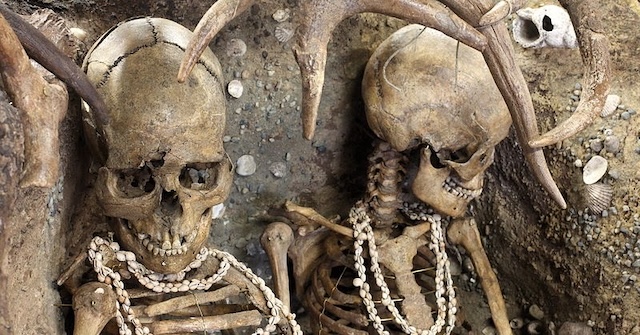
Conclusion
The grave of the Ladies of Téviec offers a compelling window into the lives and struggles of a Mesolithic community. The unique construction of their burial site, combined with the forensic evidence of their deaths, continues to captivate researchers and the public. While the exact circumstances surrounding their demise remain a mystery, the findings reveal the complexities of ancient societies and the challenges they faced. The story of the Ladies of Téviec not only reflects the ongoing fascination with historical enigmas but also underscores the importance of archaeology in uncovering the truths of our shared human past.
